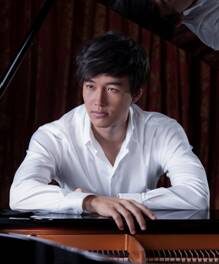For readers who might prefer an abbreviated review, the single sentence would read thusly:
“The Lysander Piano Trio (violinist Itamar Zorman, pianist Liza Stepanova, and cellist Michael Katz) thrilled the audience with masterful performances of music by Franz Schubert (1797-1828), Lili Boulanger (1893-1918), and Brian Raphael Nabors (b. 1991).”
This program of three works composed in three different centuries showed the Trio’s ability to immerse themselves into stylistically-disparate musical works and become extensions of the composers’ creative minds. Celebrating their 10th anniversary as a trio, the Lysander (the group’s name comes from Shakespeare’s Midsummer Night’s Dream) are totally “in sync” with each other and with the music.
The first two works on the program were by composers whose lives were tragically short. Composed in 1918 initially for violin and piano, then for orchestra, Lili Boulanger’s D’un matin de printemps (“Of a Spring Morning”) was effervescent, with Stepanova’s piano filigree passagework setting the mood. The Spring morning blossomed into a “Bonjour, Paris!” brilliance in its finale, the piano’s toccata passages (perhaps inspired by Boulanger’s organ professor, Louis Vierne) cascading around the powerful unison melodic lines of violin and cello.
Although Franz Schubert wrote symphonies, piano sonatas, masses, and chamber works, his musical voice never strayed far from Lieder for solo voice and piano, of which he wrote over 600. His Piano Trio No. 1 in B-flat, D. 898, composed in the last year of his all-too-short life, is full of such melodies. In the second section of the first movement Allegro moderato, the trio’s powerful opening mood recedes into this Lieder-like realm, and Zorman’s exceptionally seamless legato bowing luxuriated in Schubert’s glorious tunes, often in dialogue with Katz’s cello. The second movement, Andante un poco mosso, was exquisitely played. It contains a four-note sequence of pitches (G-F-Ab-G) which is as compelling as the four-note sequence that propels Mozart’s “Jupiter” Symphony No. 41 (and is, indeed, almost identical). The Lysander brought to fruition Robert Schumann’s comment, quoted in Joseph and Elizabeth Kahn’s superb program notes, that experiencing this B-flat trio makes “…the troubles of our human existence disappear.”
More melodies adorned the third movement Scherzo, now colored by chromaticism and rhythmic flourishes that were brilliantly executed by this dynamic young chamber group – another sign that the future of chamber music is secured by the emergence of young artists such as these. Stepanova’s nimble fingers dealt easily with all of Schubert’s technical requirements in the final Rondo: scales, trills, tremelandi, and figurations. Despite (or perhaps because of?) his fatal illness, Schubert seemed to want to include as many musical thoughts in this work as possible: in this final movement, there is even a waltz, arrived at through a deceptive cadence. All these ideas blossomed under the care of the Lysander, whose performance rivals those of some of the greatest on record, such as the Heifetz-Rubenstein-Feuerman and Stern-Istoman-Rose trios.
The Lysander has made a point of encouraging and commissioning new music for piano trio. Their concert concluded with the 2019 Piano Trio by Nabors. In three movements, this is program music (i.e., it tells a story through music rather than words), its theme recalling the Robert Louis Stevenson novel Dr. Jekyll and Mr. Hyde. The three movements: I. Hyde to Jekyll. II. A Day in the Life. III. Jekyll to Hyde. With the knowledge of that program at hand, this music conjures the images of that horror story with imaginative use of instrumental techniques unknown to Schubert or Boulanger, such as harmonic glissandi on the stringed instruments and forearm tone clusters on the piano. At the outset, we hear Hyde, then his change back to Jekyll. That first movement ends, but it really doesn’t end…. Jekyll is there, but for how long? The day continues with elements of jazz and harmonic collisions, with a few cat’s meows for decoration. Inverting the events of the opening movement, the finale leaves the music, in Nabor’s words, with Mr. Hyde having “seize(d) complete control through to the end.” This is an important new work which deserves to be widely performed — when there are musicians as superb as the Lysander Trio to perform it.
Congratulations to Chamber Music Raleigh for continuing to bring not only long-established ensembles, but also this generation’s finest, and to make it work even during this pandemic by making live performances once again possible through controlled seating, double performances two hours apart, and performers and audiences alike masked for safety.











